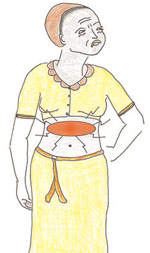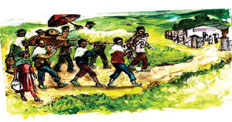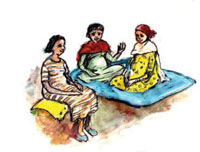
What are the risks for a young woman's health if she becomes pregnant?
What is the reason for these problems?
In Study Session 13 (Providing Focused Antenatal Care) of the Antenatal Care Module you learned that pregnancy is particularly risky for girls who are less than 16 years old. For them, in particular, childbirth may be difficult if the pelvis is still growing because it will be too small for the baby to pass through it easily (remember this is called obstructed labour).
In areas where health facilitates are inaccessible, the young woman may face an unassisted and lengthy labour which can lead to tearing or rupture of the uterus. She may die of blood loss (haemorrhage).
During a lengthy labour, the baby's head can stretch or tear the vagina causing a hole between the vagina and the bladder or between the vagina and the rectum. This hole is called a fistula.
If the baby can't pass out of the body a cut in the woman's abdomen will be made so that the baby can be lifted out of the uterus. The doctors call this operation a Caesarean section.
To avoid complications in pregnancy young women need to go for antenatal care as soon as they know they are pregnant. If you are aware of any pregnant young women in your area, you should encourage them to follow a schedule of regular antenatal care visits. If they are under 16 years old you should refer them to a higher facility for antenatal care.
What is the basic number of visits provided with focused antenatal care (FANC)?

Do you remember what you should do for the pregnant women during each visit?
In Table 11.1 write down the specific activities you should carry out at each visit.
Here are some principles that will help you complete the table.
You should also remember that the ANC service should be individualised: every woman should be counselled and treated according to her specific needs.
| First visit (when pregnancy is confirmed) | Second visit (4–6 months) | Third visit (8 months) | Fourth visit (9 months) |
|---|---|---|---|
When you have completed Table 11.1 refer to Table 11.2 at the end of this study session to see the things that you need to do at each visit.
When you are planning the care for a pregnant young woman, you should follow the same guidelines as for any other pregnant woman (i.e. use the chart that is shown in Table 11.2). However, you should give much more attention to your counselling role as a young woman has more specialised needs than an adult.
On what specific issues should you counsel a pregnant woman? (You have learned this in the Antenatal Care Module.)
Stop reading and think about whether there are specific HTPs practised in your community that could damage the health of the pregnant mother or the baby.
If the young woman is in a polygamous marriage she may not be given enough to eat; malnutrition is damaging to her and her baby. The baby will be at risk if colostrum (the thin, watery fluid produced by her breasts during the first three days of her new baby's life) is thrown away and the baby is fed other liquids and honey. You may have thought of other HTPs.
You need to counsel young woman on danger symptoms without frightening them. They should know the symptoms for which they should seek immediate help. Give reassurance and tell them about only the danger symptoms that it is appropriate to know about for the stage of their pregnancy.
What are the danger symptoms they should seek help for in the period up to 20 weeks?
What are the additional danger symptoms they should seek help for in the period after 20 weeks?

Every woman should deliver with the assistance of a skilled attendant. Although you can provide good help during childbirth you need to make every effort to enable young women to deliver in a higher health facility. Pregnant adolescents who are under 16 years of age are at particularly high risk and should always be referred for delivery to the next higher level health facility (Figure 11.2).

During antenatal visits you should help young women to develop a birth plan that focuses on:
You also need to prepare the young woman and her supporter(s) by giving them all the necessary information and techniques to make labour more comfortable.
